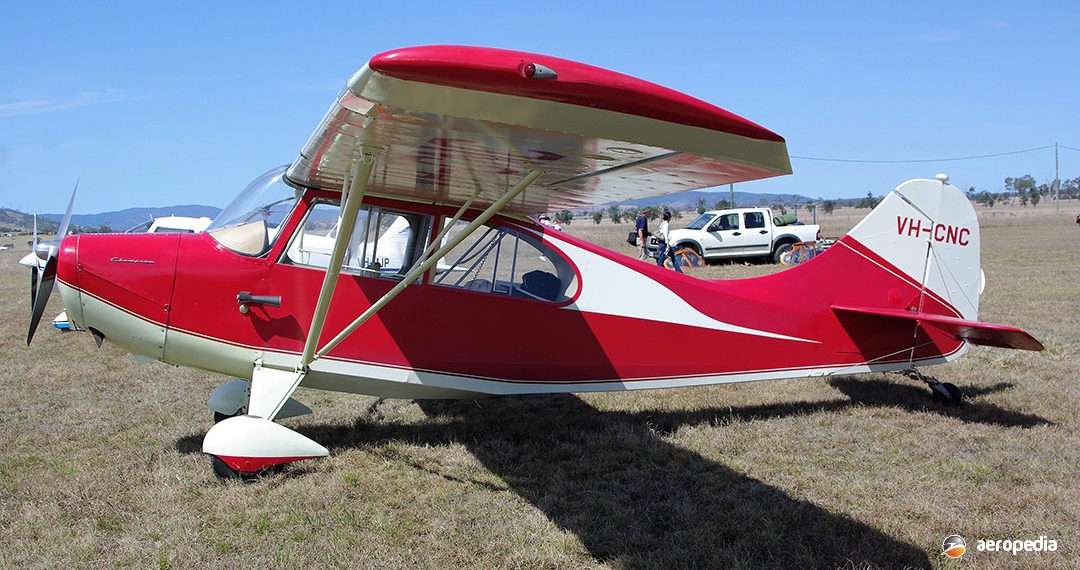Photograph:
Champion 7EC Traveller VH-CNC (c/n 0689) at Watts Bridge, QLD in August 2010 (David C Eyre)
Country of origin:
United States of America
Description:
Two-seat cabin monoplane
Power Plant:
(7EC and 7FC)
One 67 kw (90 hp) Continental C90-12F four-cylinder horizontally-opposed air-cooled engine
Specifications:
- Wingspan: 10.19 m (33 ft 5 in)
- Length: 6.56 m (21 ft 8 in)
- Height: 2.18 m (7 ft)
- Wing area: 15.33 m² (165 sq ft)
- Max speed: 216 km/h (135 mph)
- Max cruising speed: 180 km/h (112 mph)
- Stalling speed: 64 km/h (40 mph)
- Rate of climb at sea level: 275 m/min (900 ft/min)
- Range: 800 km (500 miles)
- Empty weight (7EC) 421 kg (929 lb) (7FC): 439 kg (968 lb)
- Loaded weight (both): 658 kg (1,450 lb)
History:
The Champion 7 series of aircraft was introduced in 1946 by the Aeronca Manufacturing Corporation. Subsequently Aeronca and a number of other manufacturers developed the design in various models, with various power plants. For many years it remained in production, although in much modified form.
By 1951 Aeronca had built 10,000 Champions in five main variants, which differed mainly in power and internal detail.
In 1954 the rights to manufacture the Model 7EC with the 67 kw (90 hp) Continental C90-12F engine were obtained by the Champion Aircraft Corporation and it was produced in two basic variants, the 7EC Traveller and the 7FC Tri-Traveller. The former had the standard tailwheel undercarriage, whilst the latter had a tricycle undercarriage. Minor refinements were introduced during production, and the final models were the Traveller Deluxe and the Tri-Traveller Deluxe.
Further models appeared as production continued: in 1958 the Model 7GCB Challenger with a 112 kw (150 hp) Lycoming O-320A2B engine; in 1960 the Model 7JC Tricon with a reversed tricycle undercarriage; the 7CC Sky-Trac; the 7KC Olympia with a 112 kw (150 hp) Lycoming O-320-A2B engine; and the 7ECA Citabria introduced in 1962, with a 75 kw (100 hp) Continental O-200A engine. The latter continued in production, with manufacture eventually being taken over by Bellanca in 1970.
The Model 7 series was of mixed construction, with a fabric-covered welded steel-tube fuselage, and wings comprising two wooden spars, aluminium ribs and fabric covering. Dual controls were fitted and the type was widely adopted by civil flying schools as a training aircraft.
A number of examples of the series were imported to New Zealand and these have included: Model 7EC Travellers ZK-BSX (c/n 7EC-590), ZK-BVF (c/n 7EC-637), ZK-BUU (c/n 7EC-697), and ZK-BPW (c/n 7EC-723); Model 7ECA Citabrias ZK-CMP (c/n 7ECA-318) and ZK-CPD (c/n 7ECA-329); and Model 7FC Tri-Traveller ZK-BUL (c/n 7FC-57).
Examples imported to Australia have included: Model 7EC Travellers VH-CNC (c/n 7EC-689) and VH-PTP (c/n 7EC-654); and Model 7FC Tri-Travellers VH-UEJ (c/n 7FC-281) and VH-FBP c/n (7FC-150).

